Scoring of Human Body-Balance Ability on Wobble Board Based on the Geometric Solution
Abstract
:1. Introduction
2. Experimental Conditions
2.1. Human Participants
2.2. Experimental Environment and System
3. Equivalent Model
3.1. Estimation of Center of Mass
3.2. Forward Kinematics
4. Methods
4.1. Definition of Perpendicular-Projection Point
4.2. Boundary Conditions
4.3. Scoring Algorithm
5. Results
5.1. Results of User-Interface System
5.2. Results of Verification of Scoring Algorithm
6. Discussion
6.1. Limitation of the Center of Gravity to Estimate Human Balance on the Wobble Board
6.2. Pros and Cons of Libraries and Models for Human-Pose Estimation
6.3. The Advantages and Disadvantages of Our Method
7. Conclusions
Author Contributions
Funding
Institutional Review Board Statement
Informed Consent Statement
Acknowledgments
Conflicts of Interest
References
- Hrysomallis, C. Relationship between balance ability, training and sports injury risk. Sport Med. 2007, 37, 547–556. [Google Scholar] [CrossRef]
- McGuine, T.A.; Greene, J.J.; Best, T.; Leverson, G. Balance as a predictor of ankle injuries in high school basketball players. Clin. J. Sport Med. 2000, 10, 239–244. [Google Scholar] [CrossRef]
- Watson, A.W. Ankle sprains in players of the field-games gaelic football and hurling. J. Sport Med. Phys. Fit 1999, 39, 66–70. [Google Scholar]
- Goodworth, A.D.; Johnson, M.J.; Popovic, M.B. Chapter 12: Physical Therapy and Rehabilitation. In Biomechatronics; Academic Press, Elsevier: Amsterdam, The Netherlands, 2019; pp. 333–372. [Google Scholar] [CrossRef]
- Woo, Y.; Ko, S.; Ahn, S.; Nguyen, H.T.P.; Shin, C.; Jeong, H.; Noh, B.; Lee, M.; Park, H.; Youm, C. Classification of Diabetic Walking for Senior Citizens and Personal Home Training System Using Single RGB Camera through Machine Learning. Appl. Sci. 2021, 11, 9029. [Google Scholar] [CrossRef]
- Woo, Y.; Andres, P.T.C.; Jeong, H.; Shin, C. Classification of diabetic walking through machine learning: Survey targeting senior citizens. In Proceedings of the 2021 International Conference on Artificial Intelligence in Information and Communication (ICAIIC), Jeju Island, Korea, 20–23 April 2021; Jang, Y.M., Ed.; IEEE: New York, NY, USA; pp. 435–437. [Google Scholar]
- Gebel, A.; Prieske, O.; Behm, D.G.; Granacher, U. Effects of Balance Training on Physical Fitness in Youth and Young Athletes: A Narrative Review. Strength Cond. J. 2020, 42, 35–44. [Google Scholar] [CrossRef]
- Boccolini, G.; Brazzit, A.; Bonfanti, L.; Alberti, G. Using balance training to improve the performance of youth basketball players. Sport Sci. Health 2013, 9, 37–42. [Google Scholar] [CrossRef]
- Anna, B.; Anna, K.; Justyna, M.; Michał, P.; Kajetan, J.S.; Grzegorz, J. Balance Training Programs in Athletes—A Systematic Review. J. Hum. Kinetics 2017, 58, 45–64. [Google Scholar]
- Chen, H.M.; Chen, C.M. Factors Associated with Quality of Life Among Older Adults with Chronic Disease in Taiwan. Int. J. Gerontol. 2017, 11, 12–15. [Google Scholar] [CrossRef]
- Taware, G.; Agrawal, R.; Dhende, P.; Jondhalekar, P.; Hule, S. AI-based Workout Assistant and Fitness guide. Int. J. Eng. Res. Technol. 2021, 10. [Google Scholar]
- Mutz, M.; Müller, J.; Reimers, A.K. Use of digital media for home-based sports activities during the COVID-19 pandemic: Results from the German SPOVID survey. Int. J. Environ. Res. Public Health 2021, 18, 4409. [Google Scholar] [CrossRef]
- Editorial. Top 8 AI-Based Personal Trainers. The Future Of Fitness. 2021. Available online: https://roboticsbiz.com/top-8-ai-based-personal-trainers-the-future-of-fitness/ (accessed on 29 March 2022).
- Tatariants, M. Challenges of Human Pose Estimation in AI-Powered Fitness Apps. 2020. Available online: https://www.infoq.com/articles/human-pose-estimation-ai-powered-fitness-apps/ (accessed on 29 March 2022).
- Ko, S.; Ahn, S.; Lee, J.; Woo, J.; Jeong, H.; Shin, C. Development of Fitness Personal Trainer with 3D Human Pose Estimation from 2D Images. In Proceedings of the 21st International Conference on Control, Automation and Systems, Ramada Plaze, Jeju Island, Korea, 12–15 October 2021. [Google Scholar]
- Menolotto, M.; Komaris, D.S.; Tedesco, S.; O’Flynn, B.; Walsh, M. Motion capture technology in industrial applications: A systematic review. Sensors 2020, 20, 5687. [Google Scholar] [CrossRef] [PubMed]
- Lee, C.H.; Sun, T.L. Evaluation of postural stability based on a force plate and inertial sensor during static balance measurements. J. Physiol. Anthropol. 2018, 37, 27. [Google Scholar] [CrossRef]
- Wade, L.; Needham, L.; McGuigan, P.; Bilzon, J. Applications and limitations of current markerless motion capture methods for clinical gait biomechanics. PeerJ 2022. [Google Scholar] [CrossRef]
- Jeong, H.; Yamada, K.; Kido, M.; Okada, S.; Nomura, T.; Ohno, Y. Analysis of Difference in Center-of-Pressure Positions Between Experts and Novices During Asymmetric Lifting. IEEE J. Trans. Eng. Health Med. 2016, 4, 2100311. [Google Scholar] [CrossRef]
- Jeong, H.; Ohno, Y. Symmetric lifting posture recognition of skilled experts with linear discriminant analysis by center-of-pressure velocity. Intell. Serv. Robotics 2017, 10, 323–332. [Google Scholar] [CrossRef]
- Wang, T.; Jeong, H.; Watanabe, M.; Iwatani, Y.; Ohno, Y. Fault classification with discriminant analysis during sit-to-stand movement assisted by a nursing care robot. Mech. Syst. Signal Process. 2018, 113, 90–101. [Google Scholar] [CrossRef]
- Wang, T.; Jeong, H.; Ohno, Y. Evaluation of Self-Reliance Support Robot through Relative Phase. IEEE Access 2017, 5, 17816–17823. [Google Scholar] [CrossRef]
- MediaPipe Pose. Available online: https://google.github.io/mediapipe/solutions/pose (accessed on 10 October 2021).
- Kaichi, T.; Mori, S.; Saito, H.; Takahashi, K.; Mikami, D.; Isogawa, M.; Kusachi, Y. Image-based center of mass estimation of the human body via 3D shape and kinematic structure. Sports Eng. 2019, 22, 17. [Google Scholar] [CrossRef]
- Fang, C.C.; Hsu, C.H.; Chiu, C.W.; Kung, J.T.; Shih, H.C. Center of Mass Trajectory: An Image Descriptor For Baseball Swing Analysis Based On Single Low-Cost Camera. In Proceedings of the 2021 IEEE International Conference on Multimedia & Expo Workshops (ICMEW), Shenzhen, China, 5–9 July 2021; IEEE: New York, NY, USA; Volume 1, pp. 1–5. [Google Scholar]
- De Leva, P. Adjustments to Zatsiorsky-Seluyanov ’s segment inertia parameters. J. Biomech. 1996, 29, 1223–1230. [Google Scholar] [CrossRef]
- Aftab, Z.; Robert, T.; Wieber, P.B. Balance Recovery Prediction with Multiple Strategies for Standing Humans. PLoS ONE 2016, 11, e0151166. [Google Scholar] [CrossRef]
- Waldron, K.J.; Schmiedeler, J. Chapter 1: Kinematics. In Springer Handbook of Robotics; Springer: Berlin/Heidelberg, Germany, 2016. [Google Scholar] [CrossRef]
- Takeda, K.; Mani, H.; Hasegawa, N.; Sato, Y.; Tanaka, S.; Maejima, H.; Asaka, T. Adaptation effects in static postural control by providing simultaneous visual feedback of center of pressure and center of gravity. J. Physiol. Anthropol. 2017, 36, 31. [Google Scholar] [CrossRef] [PubMed]
- Winter, D.A. Human balance and posture control during standing and walking. Gait Posture 1995, 3, 193–214. [Google Scholar] [CrossRef]
- Newell, A.; Yang, K.; Deng, J. Stacked hourglass networks for human pose estimation. In Proceedings of the European Conference on Computer Vision, Amsterdam, The Netherlands, 11–14 October 2016. [Google Scholar]
- Sigal, L.; Balan, A.O.; Black, M.J. HumanEva: Synchronized video and motion capture dataset and baseline algorithm for evaluation of articulated human motion. Int. J. Comput. Vis. 2010, 8, 4–27. [Google Scholar] [CrossRef]
- Ionescu, C.; Papava, D.; Olaru, V.; Sminchisescu, C. Human3.6M: Large scale datasets and predictive methods for 3D human sensing in natural environments. IEEE Trans. Pattern Anal. Mach. Intell. 2014, 36, 1325–1339. [Google Scholar] [CrossRef] [PubMed]
- Desmarais, Y.; Mottet, D.; Slangen, P.; Montesinos, P. A review of 3D human pose estimation algorithms for markerless motion capture. Comput. Vis. Image Underst. 2021, 212, 103275. [Google Scholar] [CrossRef]
- Intel Corporation, Willow Garage, Itseez, OpenCV. Available online: https://opencv.org/ (accessed on 30 March 2022).
- Cao, Z.; Simon, T.; Wei, S.E.; Sheikh, Y. OpenPose: Realtime Multi-Person 2D Pose Estimation using Part Affinity Fields. IEEE Trans. Pattern Anal. Mach. Intell. 2021, 43, 172–186. [Google Scholar] [CrossRef]
- Kendall, A.; Grimes, M.; Cipolla, R. PoseNet: A Convolutional Network for Real-Time 6-DOF Camera Relocalization. In Proceedings of the IEEE International Conference on Computer Vision (ICCV), Santiago, Chile, 11–18 December 2015; pp. 2380–7504. [Google Scholar]
- Wu, Y.; Kirillov, A.; Massa, F.; Lo, W.; Girshick, R. Detectron2. Available online: https://detectron2.readthedocs.io/en/latest/ (accessed on 30 March 2022).
- Fang, H.S.; Xie, S.; Tai, Y.W.; Lu, C. RMPE: Regional multi-person pose estimation. In Proceedings of the IEEE International Conference on Computer Vision (ICCV), Venice, Italy, 22–29 October 2017; pp. 2353–2362. [Google Scholar]
- Bazarevsky, V.; Grishchenko, I.; Raveendran, K.; Zhu, T.; Zhang, F.; Grundmann, M. BlazePose: On-device Real-time Body Pose tracking. In Proceedings of the CVPR Workshop on Computer Vision for Augmented and Virtual Reality, Online, 17 June 2020. [Google Scholar]
- Xu, H.; Bazavan, E.G.; Zanfir, A.; Freeman, W.T.; Sukthankar, R.; Sminchisescu, C. Ghum & ghuml: Generative 3d human shape and articulated pose models. In Proceedings of the IEEE/CVF Conference on Computer Vision and Pattern Recognition (CVPR), Seattle, WA, USA, 16–18 June 2020; pp. 6184–6193. [Google Scholar]



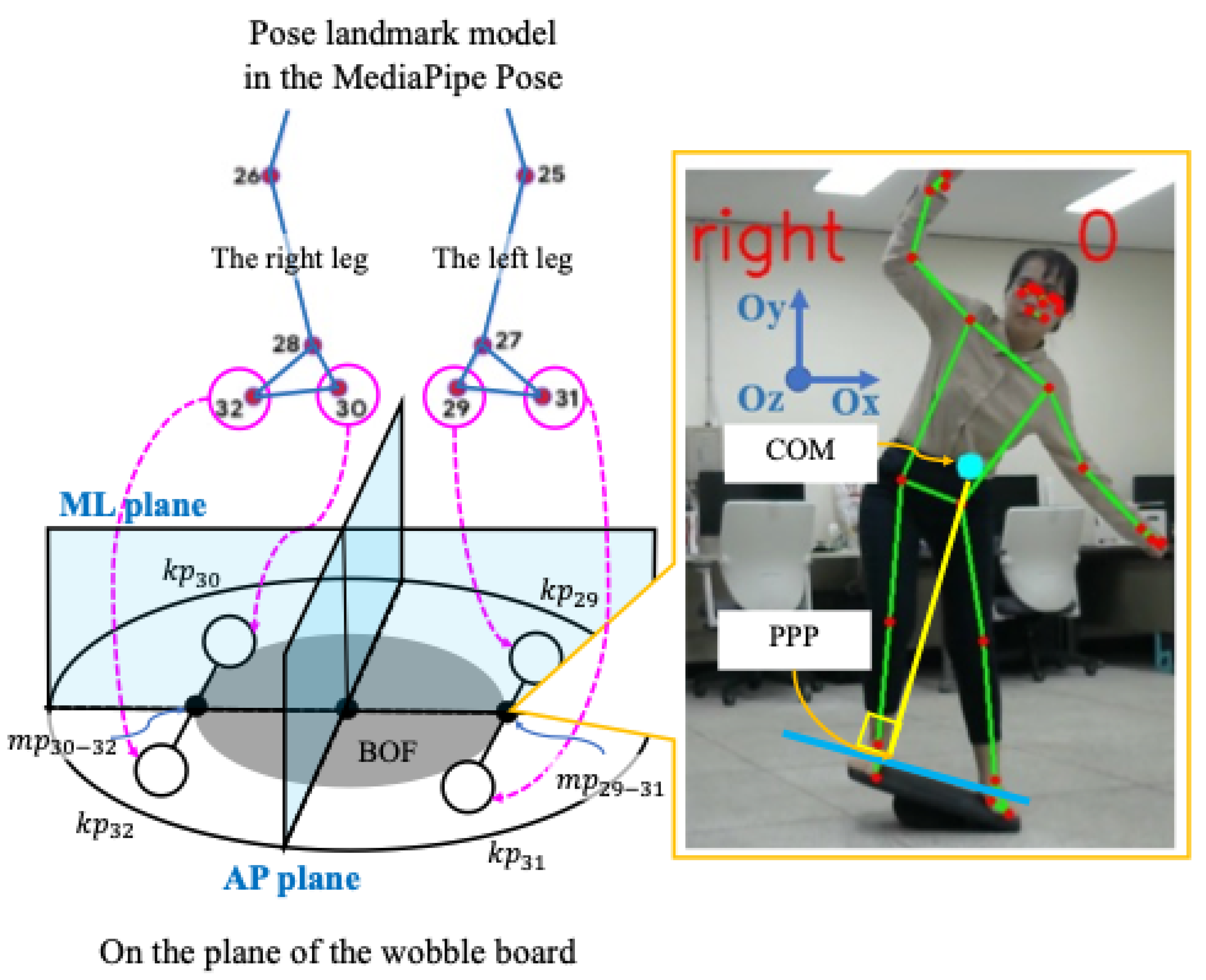
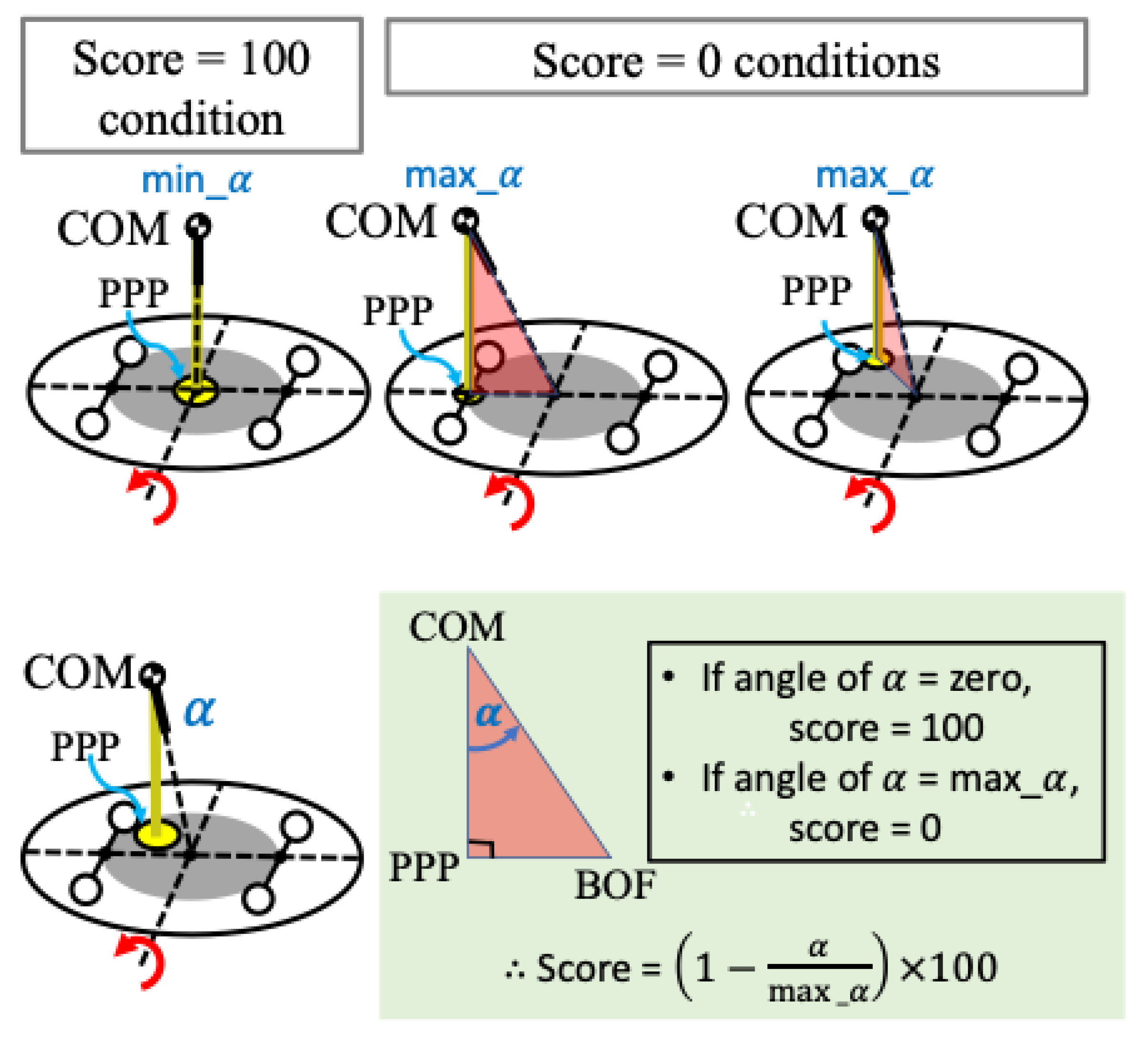
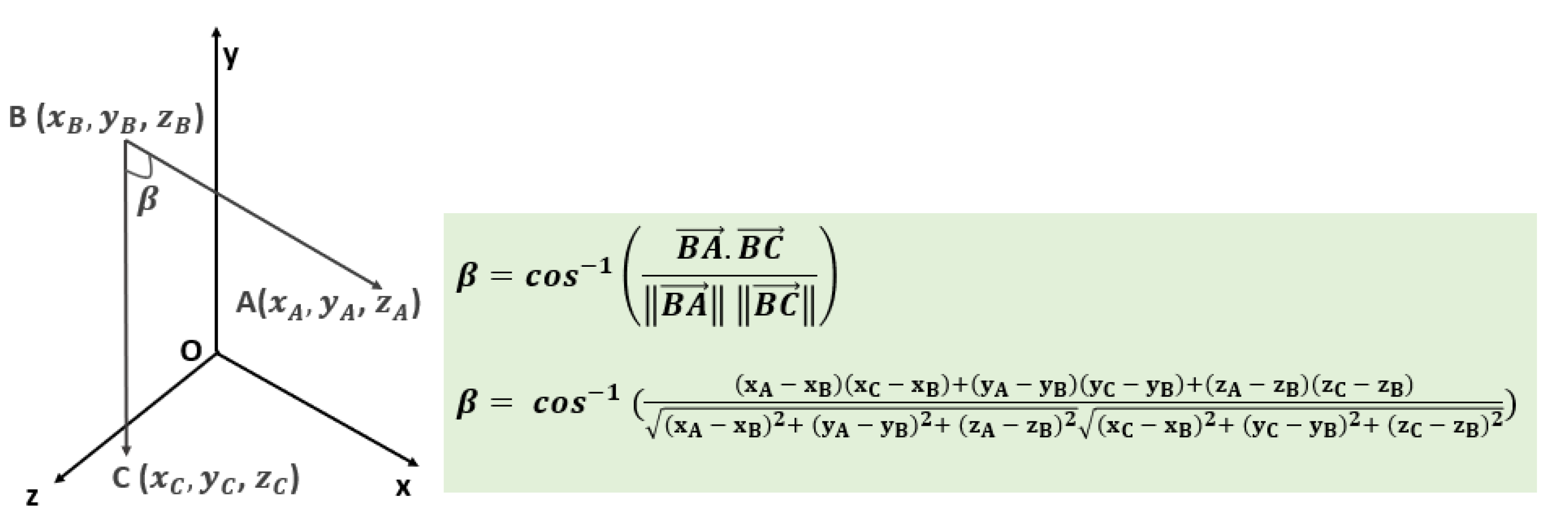
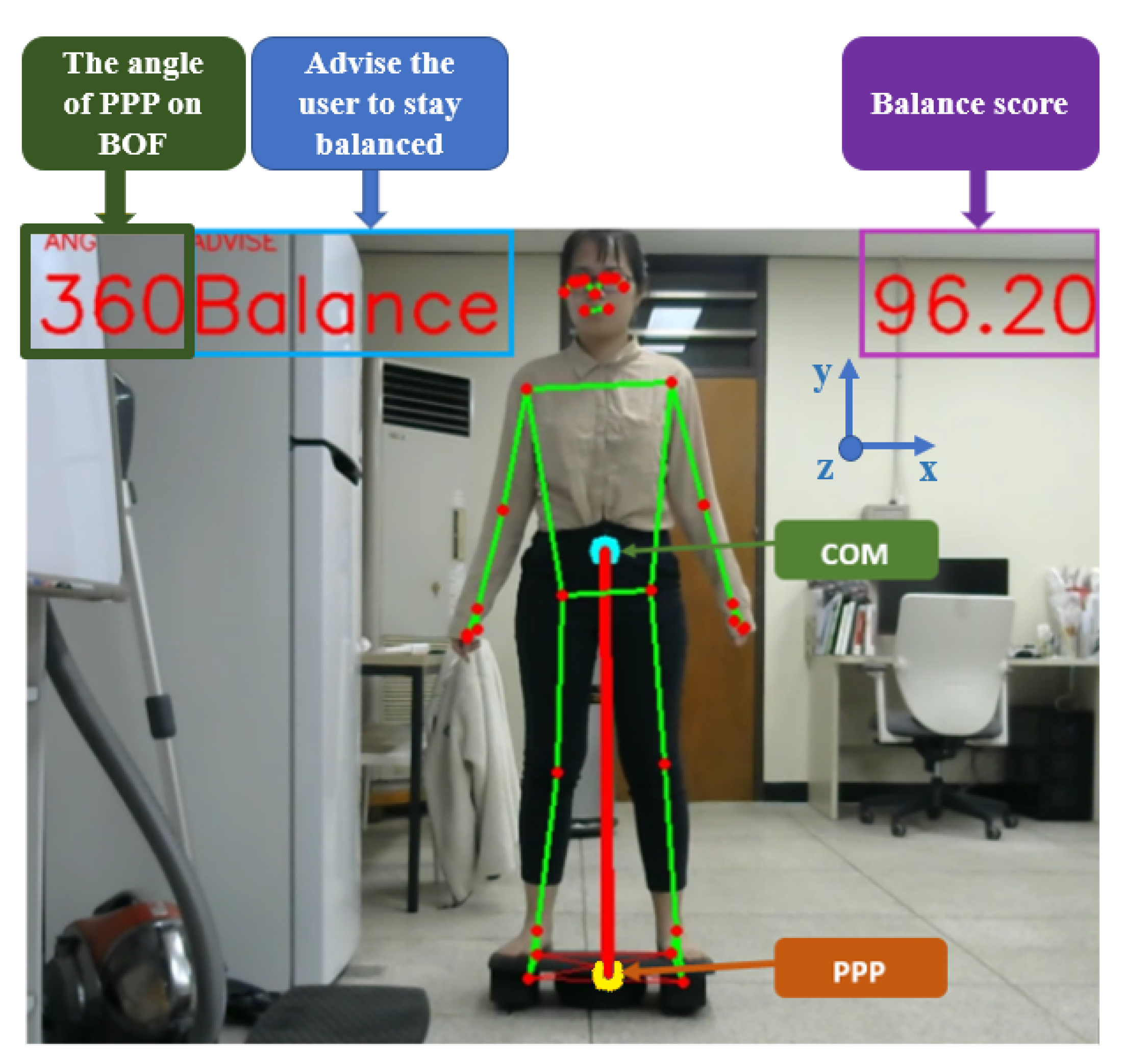

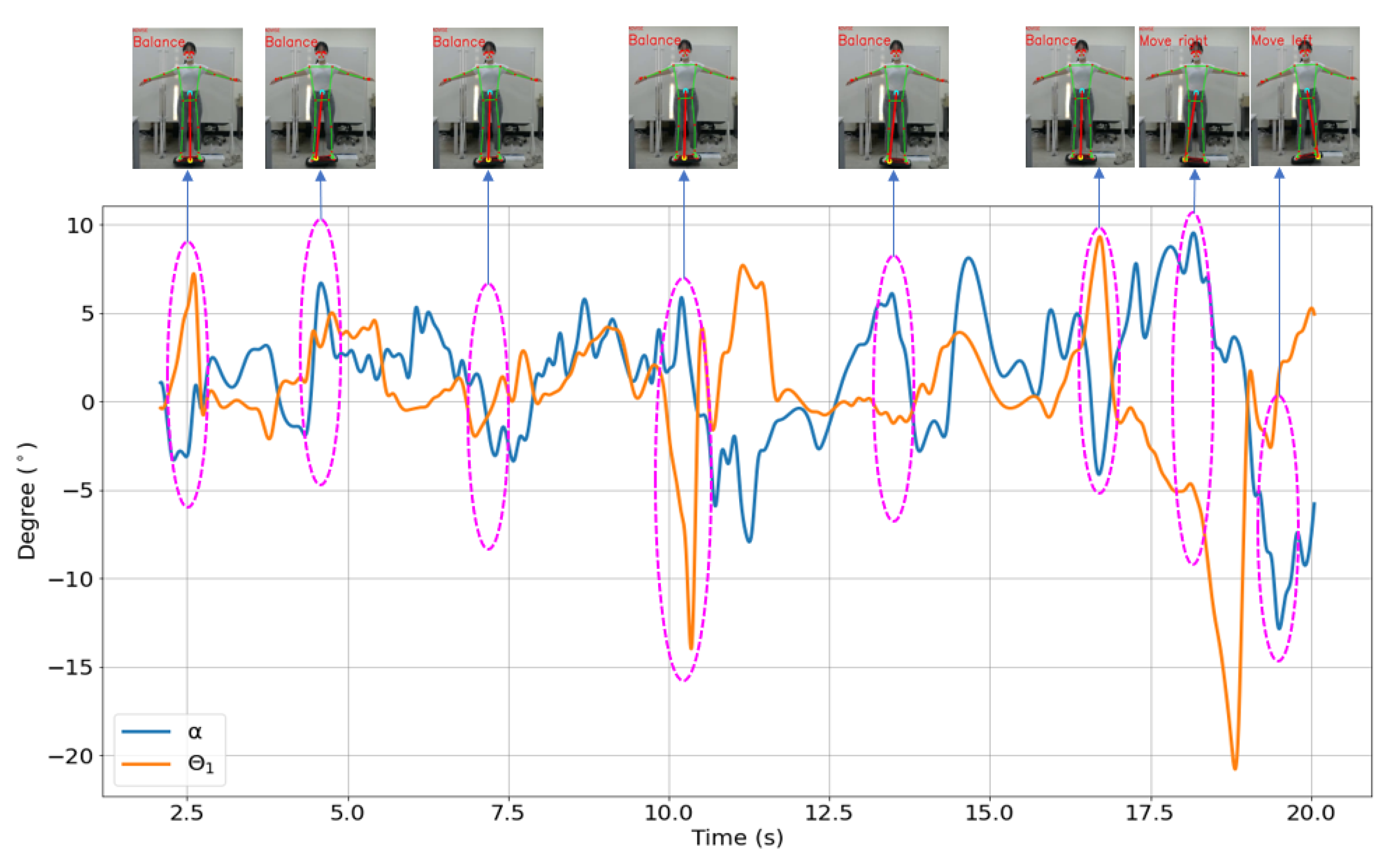

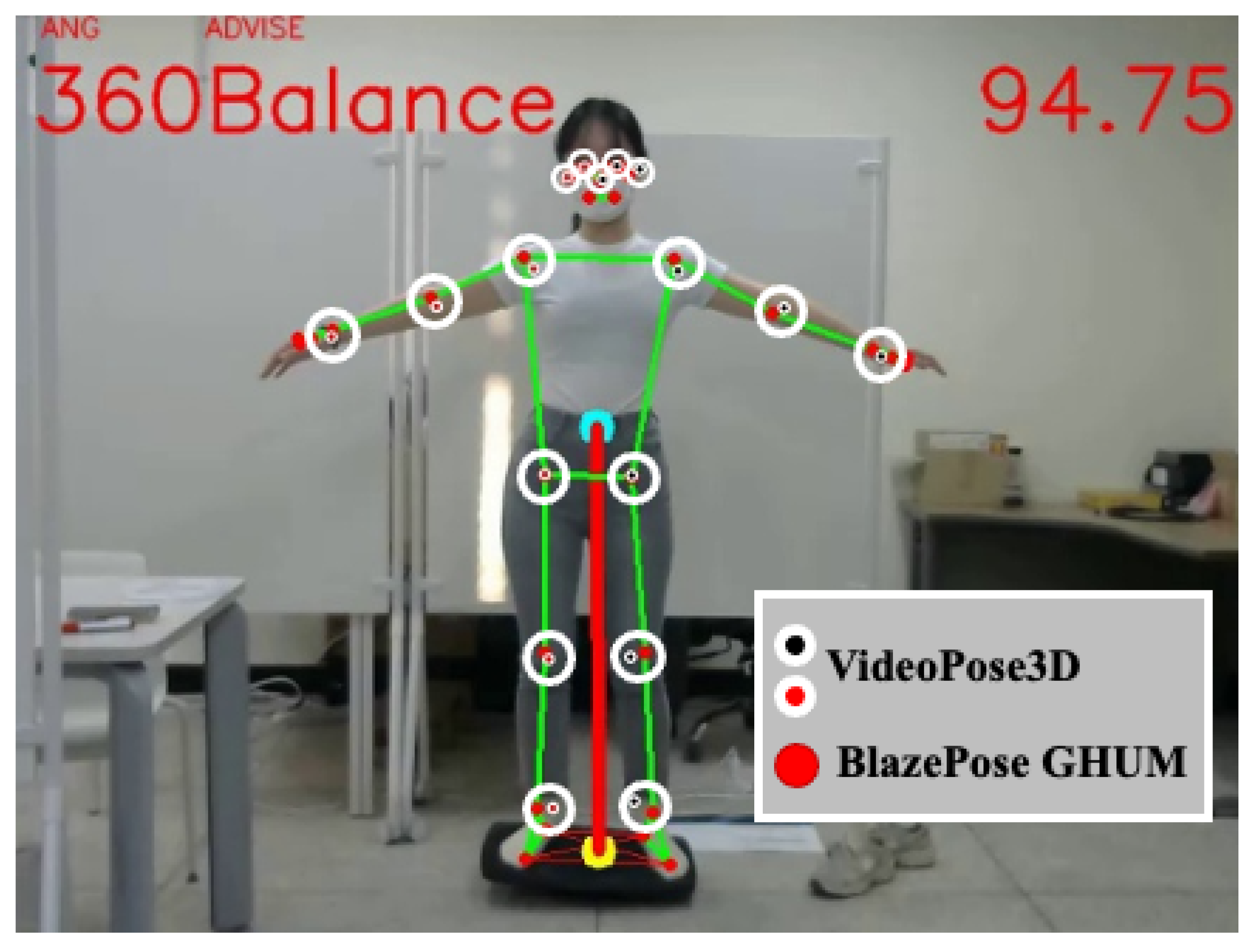
| ID | Age | Gender | Weight [kg] | Height [cm] | Max_ () |
|---|---|---|---|---|---|
| 1 | 25 | Female | 60 | 155 | 10.47 ± 0.42 |
| 2 | 28 | Female | 57 | 156 | 10.35 ± 0.32 |
| 3 | 23 | Female | 50 | 162 | 8.40 ± 0.26 |
| 4 | 25 | Female | 52 | 162 | 8.40 ± 0.33 |
| 5 | 36 | Male | 80 | 170 | 8.77 ± 0.68 |
| 6 | 45 | Male | 80 | 170 | 9.3 ± 0.54 |
| 7 | 27 | Male | 81 | 170 | 9.70 ± 0.74 |
| 8 | 30 | Male | 69 | 173 | 9.28 ± 0.59 |
| 9 | 27 | Male | 73 | 176 | 8.32 ± 0.82 |
| 10 | 22 | Male | 59 | 180 | 8.06 ± 0.33 |
| Methods | Pros | Cons |
|---|---|---|
| OpenCV [35] | – many tutorials to instruct the setting up and employing the models | – difficult to customize |
| – useful built-in tools for processing and analyzing the content of images’ computer-vision tasks | – the real-time performance is most likely poor | |
| OpenPose [36] | – combined full-body keypoints detection | – only non-commercial use |
| – provide the flexibility of choosing source images from camera fields, webcams, and others | – real-time performance is poor if only on the CPU | |
| PoseNet [37] | – runs on lightweight devices such as a browser or mobile device | – medium accuracy |
| – be able to estimate a single pose or multiple poses | – be deficient for some of the pose estimation applications | |
| – inference time is fast | ||
| Detectron2 [38] | – a huge amount of models available | – no real-time performance, mostly on the CPU |
| – high accuracy | ||
| AlphaPose [39] | – can detect both single- and multi-person poses in images or videos | – only non-commercial use |
| – pose tracking | – mostly does not perform in real time on CPU | |
| – high accuracy |
Publisher’s Note: MDPI stays neutral with regard to jurisdictional claims in published maps and institutional affiliations. |
© 2022 by the authors. Licensee MDPI, Basel, Switzerland. This article is an open access article distributed under the terms and conditions of the Creative Commons Attribution (CC BY) license (https://creativecommons.org/licenses/by/4.0/).
Share and Cite
Nguyen, H.T.P.; Woo, Y.; Huynh, N.N.; Jeong, H. Scoring of Human Body-Balance Ability on Wobble Board Based on the Geometric Solution. Appl. Sci. 2022, 12, 5967. https://doi.org/10.3390/app12125967
Nguyen HTP, Woo Y, Huynh NN, Jeong H. Scoring of Human Body-Balance Ability on Wobble Board Based on the Geometric Solution. Applied Sciences. 2022; 12(12):5967. https://doi.org/10.3390/app12125967
Chicago/Turabian StyleNguyen, Hang Thi Phuong, Yeongju Woo, Ngoc Nguyen Huynh, and Hieyong Jeong. 2022. "Scoring of Human Body-Balance Ability on Wobble Board Based on the Geometric Solution" Applied Sciences 12, no. 12: 5967. https://doi.org/10.3390/app12125967







